IBM 2296, 8191, 8198, 8316, 8199 User Manual
...ThinkCentre™ |
|
User Guide
Types 2296, 8191, 8198, 8199, 8316, 8434
ThinkCentre™ |
|
User Guide
Types 2296, 8191, 8198, 8199, 8316, 8434

Note
Before using this information and the product it supports, be sure to read the “Safety Information” on page v and Appendix E, “Notices”, on page 111.
First Edition (June 2003)
© Copyright International Business Machines Corporation 2003. All rights reserved.
US Government Users Restricted Rights – Use, duplication or disclosure restricted by GSA ADP Schedule Contract with IBM Corp.

Contents
Safety Information . . . . . . . . . |
. v |
Installing adapters . . . . . . . . . . . |
. |
34 |
||||
Lithium battery notice . . . . . . . . . . |
. vi |
Installing internal drives . . . . . . . . . |
. |
36 |
||||
Modem safety information . . . . . . . . |
. vi |
Drive specifications. . . . . . . . . . |
. |
36 |
||||
Laser compliance statement . . . . . . . . |
. vii |
Installing a drive . . . . . . . . . . |
. |
37 |
||||
|
|
|
|
Installing security features . . . . . . . . |
. |
40 |
||
Overview . . . . . . . . . . . . . |
. ix |
Identifying security locks . . . . . . . . |
. |
40 |
||||
Information resources . . . . . . . . . . |
. ix |
Rope clip . . . . . . . . . . . . . |
. |
40 |
||||
Integrated cable lock . . . . . . . . . |
. |
42 |
||||||
Identifying your computer. . . . . . . . |
. |
. x |
||||||
Password protection . . . . . . . . . |
. |
42 |
||||||
|
|
|
|
|||||
Chapter 1. Type 8316 . . . . . . . . |
. |
|
1 |
Changing the battery . . . . . . . . . . |
. |
42 |
||
|
Erasing a lost or forgotten password (clearing |
|
|
|
||||
Features . . . . . . . . . . . . . . . |
. |
1 |
|
|
|
|||
CMOS) . . . . . . . . . . . . . . |
. . 43 |
|||||||
Specifications . . . . . . . . . . . . . |
. |
4 |
||||||
Replacing the cover and connecting the cables. . . 44 |
||||||||
Available options . . . . . . . . . . . |
. |
. |
5 |
|||||
|
|
|
|
|||||
Tools required . . . . . . . . . . . . |
. |
. |
5 |
Chapter 3. Types 2296 and 8434 . . . |
|
. 45 |
||
Handling static-sensitive devices. . . . . . |
. |
. |
5 |
|
||||
Features . . . . . . . . . . . . . . |
. |
45 |
||||||
Installing external options . . . . . . . . |
. |
. |
6 |
|||||
Specifications . . . . . . . . . . . . . |
. |
48 |
||||||
Locating the connectors on the front of your |
|
|
|
|||||
|
|
|
Available options . . . . . . . . . . . |
. |
49 |
|||
computer . . . . . . . . . . . . |
. |
. |
6 |
|||||
Tools required . . . . . . . . . . . . |
. |
49 |
||||||
Locating the connectors on the rear of your |
|
|
|
|||||
|
|
|
Handling static-sensitive devices . . . . . . |
. |
49 |
|||
computer . . . . . . . . . . . . |
. |
. |
7 |
|||||
Installing external options . . . . . . . . |
. |
50 |
||||||
Obtaining device drivers . . . . . . . |
. |
. |
8 |
|||||
Locating the connectors on the front of your |
|
|
|
|||||
Removing the cover . . . . . . . . . . |
. |
. |
9 |
|
|
|
||
computer . . . . . . . . . . . . . |
. |
51 |
||||||
Locating components . . . . . . . . . . |
. |
|
10 |
|||||
|
Locating the connectors on the rear of your |
|
|
|
||||
Identifying parts on the system board . . . . |
. 10 |
|
|
|
||||
computer . . . . . . . . . . . . . |
. |
52 |
||||||
Installing memory . . . . . . . . . . . |
. |
|
11 |
|||||
|
Obtaining device drivers . . . . . . . . |
. |
53 |
|||||
Installing adapters . . . . . . . . . . . |
. |
|
12 |
|||||
|
Removing the cover . . . . . . . . . . |
. |
54 |
|||||
Installing internal drives . . . . . . . . . |
. |
|
14 |
|||||
|
Locating components . . . . . . . . . . |
. |
55 |
|||||
Drive specifications. . . . . . . . . . |
. |
|
14 |
|||||
|
Identifying parts on the system board . . . . |
. 55 |
||||||
Installing a CD-ROM or DVD-ROM drive . . |
. 15 |
|||||||
Installing memory . . . . . . . . . . . |
. |
56 |
||||||
Installing security features . . . . . . . . |
. |
|
17 |
|||||
|
Installing adapters . . . . . . . . . . . |
. |
58 |
|||||
Identifying security locks . . . . . . . . |
. |
|
17 |
|||||
|
Installing internal drives . . . . . . . . . |
. |
59 |
|||||
Rope clip . . . . . . . . . . . . . |
. |
|
17 |
|||||
|
Drive specifications. . . . . . . . . . |
. |
59 |
|||||
Integrated cable lock . . . . . . . . . |
. |
|
19 |
|||||
|
Installing a drive . . . . . . . . . . |
. |
60 |
|||||
Password protection . . . . . . . . . |
. |
|
19 |
|||||
|
Installing security features . . . . . . . . |
. |
62 |
|||||
Changing the battery . . . . . . . . . . |
. |
|
19 |
|||||
|
Identifying security locks . . . . . . . . |
. |
63 |
|||||
Erasing a lost or forgotten password (clearing |
|
|
|
|||||
|
|
|
Rope clip . . . . . . . . . . . . . |
. |
63 |
|||
CMOS) . . . . . . . . . . . . . . . . |
|
20 |
||||||
|
Integrated cable lock . . . . . . . . . |
. |
65 |
|||||
Replacing the cover and connecting the cables. . . 21 |
||||||||
Password protection . . . . . . . . . |
. |
65 |
||||||
|
|
|
|
|||||
Chapter 2. Type 8191. . . . . . . . |
. |
23 |
Changing the battery . . . . . . . . . . |
. |
65 |
|||
Erasing a lost or forgotten password (clearing |
|
|
|
|||||
Features . . . . . . . . . . . . . . |
. |
|
23 |
|
|
|
||
|
CMOS) . . . . . . . . . . . . . . |
. . 66 |
||||||
Specifications . . . . . . . . . . . . . . |
|
26 |
||||||
|
Replacing the cover and connecting the cables. . . 67 |
|||||||
Available options . . . . . . . . . . . |
. |
|
27 |
|||||
|
|
|
|
|
||||
Tools required . . . . . . . . . . . . |
. |
|
27 |
Chapter 4. Types 8198 and 8199 . . . |
|
. 69 |
||
Handling static-sensitive devices . . . . . . |
. |
|
27 |
|
||||
|
Features . . . . . . . . . . . . . . |
. |
69 |
|||||
Installing external options . . . . . . . . |
. |
|
28 |
|||||
|
Specifications . . . . . . . . . . . . . |
. |
72 |
|||||
Locating the connectors on the front of your |
|
|
|
|||||
|
|
|
Available options . . . . . . . . . . . |
. |
73 |
|||
computer . . . . . . . . . . . . . |
. |
|
28 |
|||||
|
Tools required . . . . . . . . . . . . |
. |
73 |
|||||
Locating the connectors on the rear of your |
|
|
|
|||||
|
|
|
Handling static-sensitive devices . . . . . . |
. |
73 |
|||
computer . . . . . . . . . . . . . . |
|
29 |
||||||
|
Installing external options . . . . . . . . |
. |
74 |
|||||
Obtaining device drivers . . . . . . . . |
. |
|
30 |
|||||
|
Locating the connectors on the front of your |
|
|
|
||||
Removing the cover . . . . . . . . . . |
. |
|
31 |
|
|
|
||
|
computer . . . . . . . . . . . . . |
. |
75 |
|||||
Locating components . . . . . . . . . . |
. |
|
32 |
|||||
|
Locating the connectors on the rear of your |
|
|
|
||||
Identifying parts on the system board . . . . |
. 32 |
|
|
|
||||
computer . . . . . . . . . . . . . |
. |
76 |
||||||
Installing memory . . . . . . . . . . . |
. |
|
33 |
|||||
|
|
|
|
|
||||
© Copyright IBM Corp. 2003 |
|
|
|
|
|
|
iii |
|
Obtaining device drivers . . . . |
. |
. . . |
. |
77 |
Removing the cover . . . . . . |
. |
. . . |
. |
78 |
Locating components . . . . . . |
. |
. . . |
. |
79 |
Identifying parts on the system board |
. |
. . . |
. 79 |
|
Installing memory . . . . . . . |
. |
. . . |
. |
80 |
Installing adapters . . . . . . . |
. |
. . . |
. |
81 |
Installing internal drives . . . . . |
. |
. . . |
. |
83 |
Drive specifications. . . . . . |
. |
. . . |
. |
83 |
Installing a drive . . . . . . |
. |
. . . |
. |
84 |
Installing security features . . . . |
. |
. . . |
. |
87 |
Identifying security locks . . . . |
. |
. . . |
. |
87 |
Rope clip . . . . . . . . . |
. |
. . . |
. |
88 |
Integrated cable lock . . . . . |
. |
. . . |
. |
89 |
Password protection . . . . . |
. |
. . . |
. |
89 |
Changing the battery . . . . . . |
. |
. . . |
. |
89 |
Erasing a lost or forgotten password (clearing
CMOS) . . . . . . . . . . . . . . . . 90 Replacing the cover and connecting the cables. . . 91
Chapter 5. Using the IBM Setup Utility program . . . . . . . . . . . . . . 93
Starting the IBM Setup Utility program . . . |
. |
. 93 |
|
Viewing and changing settings . . . . . . |
. |
. |
93 |
Exiting from the IBM Setup Utility program . |
. |
. 93 |
|
Using passwords . . . . . . . . . . |
. |
. |
93 |
User password . . . . . . . . . . |
. |
. |
94 |
Administrator password . . . . . . . |
. |
. |
94 |
Setting, changing, and deleting a password . . . 94 |
|||
Using Security Profile by Device . . . . . |
. |
. |
94 |
Selecting a startup device. . . . . . . . |
. |
. |
95 |
Selecting a temporary startup device . . . |
. |
. |
95 |
Changing the startup sequence . . . . . |
. |
. |
95 |
Appendix A. Updating system |
|
|
programs . . . . . . . . . . . |
. |
. 97 |
System programs . . . . . . . . . . |
. |
. 97 |
Updating (flashing) BIOS from a diskette . |
. |
. 97 |
Updating (flashing) BIOS from your operating system . . . . . . . . . . . . . . . 97
Recovering from a POST/BIOS update failure . . . 98
Appendix B. Cleaning the mouse . |
. |
. 99 |
Cleaning an optical mouse . . . . . . . |
. |
. 99 |
Cleaning a mouse with a ball . . . . . . |
. |
. 99 |
Appendix C. Manual modem |
|
|
commands . . . . . . . . . . . |
. |
101 |
Basic AT commands . . . . . . . . . |
. |
. 101 |
Extended AT commands. . . . . . . . |
. |
. 103 |
MNP/V.42/V.42bis/V.44 commands . . . . |
. |
. 104 |
Fax Class 1 commands . . . . . . . . |
. |
. 105 |
Fax Class 2 commands . . . . . . . . |
. |
. 105 |
Voice commands . . . . . . . . . . |
. |
. 106 |
Appendix D. Customer replaceable |
|
|
unit (CRU) parts list . . . . . . . |
. |
109 |
Appendix E. Notices . . . . . . . |
. |
111 |
Television output notice . . . . . . . . |
. |
. 112 |
Trademarks . . . . . . . . . . . . . . 112 |
||
Index . . . . . . . . . . . . . . |
. |
113 |
iv User Guide

Safety Information
DANGER
Electrical current from power, telephone, and communication cables is hazardous.
To avoid a shock hazard:
vDo not connect or disconnect any cables or perform installation, maintenance, or reconfiguration of this product during an electrical storm.
vConnect all power cords to a properly wired and grounded electrical outlet.
vConnect to properly wired outlets any equipment that will be attached to this product.
vWhen possible, use one hand only to connect or disconnect signal cables.
vNever turn on any equipment when there is evidence of fire, water, or structural damage.
vDisconnect the attached power cords, telecommunications systems, networks, and modems before you open the device covers, unless instructed otherwise in the installation and configuration procedures.
vConnect and disconnect cables as described in the following table when installing, moving, or opening covers on this product or attached devices.
To connect: |
To disconnect: |
||
1. |
Turn everything OFF. |
1. |
Turn everything OFF. |
2. |
First, attach all cables to devices. |
2. |
First, remove power cords from outlet. |
3. |
Attach signal cables to connectors. |
3. |
Remove signal cables from connectors. |
4. |
Attach power cords to outlet. |
4. |
Remove all cables from devices. |
5. |
Turn device ON. |
|
|
|
|
|
|
DANGER
Le courant électrique provenant de l’alimentation, du téléphone et des câbles de transmission peut présenter un danger.
Pour éviter tout risque de choc électrique :
vNe manipulez aucun câble et n’effectuez aucune opération d’installation, d’entretien ou de reconfiguration de ce produit au cours d’un orage.
vBranchez tous les cordons d’alimentation sur un socle de prise de courant correctement câblé et mis à la terre.
vBranchez sur des socles de prise de courant correctement câblés tout équipement connecté à ce produit.
vLorsque cela est possible, n’utilisez qu’une seule main pour connecter ou déconnecter les câbles d’interface.;
vNe mettez jamais un équipement sous tension en cas d’incendie ou d’inondation, ou en présence de dommages matériels.
vAvant de retirer les carters de l’unité, mettez celle-ci hors tension et déconnectez ses cordons d’alimentation, ainsi que les câbles qui la relient aux
© Copyright IBM Corp. 2003 |
v |

réseaux, aux systèmes de té lécommunication et aux modems (sauf instruction contraire mentionnée dans les procédures d’installation et de configuration).
vLorsque vous installez, que vous déplacez, ou que vous manipulez le présent produit ou des périphériques qui lui sont raccordés, reportez-vous aux instructions ci-dessous pour connecter et déconnecter les différents cordons.
Connexion: |
Déconnexion: |
||
1. |
Mettez les unités hors tension. |
1. |
Mettez les unités hors tension. |
2. |
Commencez par brancher tous les |
2. |
Débranchez les cordons d’alimentation |
|
cordons sur les unités. |
|
des prises. |
3. |
Branchez les câbles d’interface sur des |
3. |
Débranchez les câbles d’interface des |
|
connecteurs. |
|
connecteurs. |
4. |
Branchez les cordons d’alimentation sur |
4. |
Débranchez tous les câbles des unités. |
|
des prises. |
|
|
5. |
Mettez les unités sous tension. |
|
|
|
|
|
|
Lithium battery notice
CAUTION:
Danger of explosion if battery is incorrectly replaced.
When replacing the battery, use only IBM Part Number 33F8354 or an equivalent type battery recommended by the manufacturer. The battery contains lithium and can explode if not properly used, handled, or disposed of.
Do not:
vThrow or immerse into water
vHeat to more than 100°C (212°F)
vRepair or disassemble
Dispose of the battery as required by local ordinances or regulations.
ATTENTION
Danger d’explosion en cas de remplacement incorrect de la batterie.
Remplacer uniquement par une batterie IBM de type ou d’un type équivalent recommandé par le fabricant. La batterie contient du lithium et peut exploser en cas de mauvaise utilisation, de mauvaise manipulation ou de mise au rebut inappropriée.
Ne pas :
vLancer ou plonger dans l’eau
vChauffer à plus de 100°C (212°F)
vRéparer ou désassembler
Mettre au rebut les batteries usagées conformément aux règlements locaux.
Modem safety information
To reduce the risk of fire, electrical shock, or injury when using telephone equipment, always follow basic safety precautions, such as:
v Never install telephone wiring during a lightning storm.
vi User Guide

vNever install telephone jacks in wet locations unless the jack is specifically designed for wet locations.
vNever touch uninsulated telephone wires or terminals unless the telephone line has been disconnected at the network interface.
vUse caution when installing or modifying telephone lines.
vAvoid using a telephone (other than a cordless type) during an electrical storm. There may be a remote risk of electric shock from lightning.
vDo not use the telephone to report a gas leak in the vicinity of the leak.
Consignes de sécurité relatives au modem
Lors de l’utilisation de votre matériel téléphonique, il est important de respecter les consignes ci-après afin de réduire les risques d’incendie, d’électrocution et d’autres blessures :
vN’installez jamais de cordons téléphoniques durant un orage.
vLes prises téléphoniques ne doivent pas être installées dans des endroits humides, excepté si le modèle a été conçu à cet effet.
vNe touchez jamais un cordon téléphonique ou un terminal non isolé avant que la ligne ait été déconnectée du réseau téléphonique.
vSoyez toujours prudent lorsque vous procédez à l’installation ou à la modification de lignes téléphoniques.
vSi vous devez téléphoner pendant un orage, pour éviter tout risque de choc électrique, utilisez toujours un téléphone sans fil.
vEn cas de fuite de gaz, n’utilisez jamais un téléphone situé à proximité de la fuite.
Laser compliance statement
Some IBM Personal Computer models are equipped from the factory with a CD-ROM drive or a DVD-ROM drive. CD-ROM drives and DVD-ROM drives are also sold separately as options. CD-ROM drives and DVD-ROM drives are laser products. These drives are certified in the U.S. to conform to the requirements of the Department of Health and Human Services 21 Code of Federal Regulations (DHHS 21 CFR) Subchapter J for Class 1 laser products. Elsewhere, these drives are certified to conform to the requirements of the International Electrotechnical Commission (IEC) 825 and CENELEC EN 60 825 for Class 1 laser products.
When a CD-ROM drive or a DVD-ROM drive is installed, note the following handling instructions.
CAUTION:
Use of controls or adjustments or performance of procedures other than those specified herein might result in hazardous radiation exposure.
Removing the covers of the CD-ROM drive or DVD-ROM drive could result in exposure to hazardous laser radiation. There are no serviceable parts inside the CD-ROM drive or DVD-ROM drive. Do not remove the drive covers.
Some CD-ROM drives and DVD-ROM drives contain an embedded Class 3A or Class 3B laser diode. Note the following statement.
Safety Information vii

DANGER
Laser radiation when open. Do not stare into the beam, do not view directly with optical instruments, and avoid direct exposure to the beam.
DANGER:
Certains modèles d’ordinateurs personnels sont équipés d’origine d’une unité de CD-ROM ou de DVD-ROM. Mais ces unités sont également vendues séparément en tant qu’options. L’unité de CD-ROM/DVD-ROM est un appareil à laser. Aux État-Unis, l’unité de CD-ROM/DVD-ROM est certifiée conforme aux normes indiquées dans le sous-chapitre J du DHHS 21 CFR relatif aux produits à laser de classe 1. Dans les autres pays, elle est certifiée être un produit à laser de classe 1 conforme aux normes CEI 825 et CENELEC EN 60 825.
Lorsqu’une unité de CD-ROM/DVD-ROM est installée, tenez compte des remarques suivantes:
ATTENTION: Pour éviter tout risque d’exposition au rayon laser, respectez les consignes de réglage et d’utilisation des commandes, ainsi que les procédures décrites.
L’ouverture de l’unité de CD-ROM/DVD-ROM peut entraîner un risque d’exposition au rayon laser. Pour toute intervention, faites appel à du personnel qualifié.
Certaines unités de CD-ROM/DVD-ROM peuvent contenir une diode à laser de classe 3A ou 3B. Tenez compte de la consigne qui suit:
DANGER
Rayonnement laser lorsque le carter est ouvert. Évitez toute exposition directe des yeux au rayon laser. Évitez de regarder fixement le faisceau ou de l’observer à l’aide d’instruments optiques.
viii User Guide

Overview
Thank you for selecting an IBM® computer. Your computer incorporates many of the latest advances in computer technology and can be upgraded as your needs change.
This publication supports several computer models. Information in this section will help you identify your computer and help you find the chapter that contains information specific to your computer.
Adding hardware options to your computer is an easy way to increase its capabilities. Instructions for installing external and internal options are included in this publication. When adding an option, use these instructions along with the instructions that come along with the option.
Information resources
The Quick Reference that comes with your computer provides information for installing your computer and starting the operating system. It also includes basic troubleshooting information, software recovery procedures, help and service information, and warranty information.
Access IBM, on your desktop, provides a link to more information about your computer.
If you have Internet access, the most up-to-date manuals for your computer are available from the World Wide Web. To access this information, point your browser to
http://www.ibm.com/pc/support
Type your machine type and model number in the Quick Path field, and click Go.
© Copyright IBM Corp. 2003 |
ix |

Identifying your computer
See Chapter 1, “Type 8316”, on page 1.
See Chapter 2, “Type 8191”, on page 23.
See Chapter 3, “Types 2296 and 8434”,
on page 45.
See Chapter 4, “Types 8198 and 8199”,
on page 69.
x User Guide

Chapter 1. Type 8316
This chapter provides an introduction to the features and options that are available for your computer. You can expand the capabilities of your computer by adding memory, adapters, or drives. When installing an option, use these instructions along with the instructions that come with the option.
Important
Before you install or remove any option, read “Safety Information” on page v.
These precautions and guidelines will help you work safely.
Features
This section provides an overview of the computer features and preinstalled software.
System information
The following information covers a variety of models. For information for your specific model, use the IBM Setup Utility. See Chapter 5, “Using the IBM Setup Utility program”, on page 93.
Microprocessor (varies by model type)
Intel® Pentium® 4 processor with 256 KB or 512 KB of internal L2 cache memory and Intel NetBurst™ micro-architecture
Memory
vSupport for two dual inline memory modules (DIMMs)
v512 KB flash memory for system programs
Internal drives
v3.5-inch, 1.44 MB diskette drive
vInternal hard disk drive
vEIDE CD-ROM drive or DVD-ROM drive (some models)
© Copyright IBM Corp. 2003 |
1 |
Video subsystem
vIntel Extreme™ graphics
vAccelerated graphics port (AGP) video adapter slot on the system board (some models)
Audio subsystem
Integrated SoundMAX 3 audio
Connectivity
v10/100 Mbps integrated Intel Ethernet controller that supports the Wake on LAN® feature
vSoft modem V.90/V.44 (some models)
System management features
vRemote Program Load (RPL) and Dynamic Host Configuration Protocol (DHCP)
vWake on LAN
vWake on Ring (in the IBM Setup Utility program, this feature is called Serial Port Ring Detect for an external modem and Modem Ring Detect for an internal modem)
vRemote Administration
vAutomatic power-on startup
vSystem Management (SM) BIOS and SM software
vAbility to store POST hardware test results
Input/output features
v25-pin, Extended Capabilities Port (ECP)/Extended Parallel Port (EPP)
vTwo 9-pin serial connectors
vSix 4-pin, USB connectors
vPS/2® mouse connector
vPS/2 keyboard connector
vEthernet connector
vVGA monitor connector
vThree audio connectors (line in, line out, and microphone)
vFront connectors for headphone, microphone, IEEE 1394, and S/PDIF (some models)
Expansion
vThree drive bays
vThree 32-bit peripheral component interconnect (PCI) adapter slots (supports low-profile adapters only)
vOne accelerated graphics port (AGP) expansion slot (supports low-profile adapters only)
Power
v200 W power supply with manual voltage selection switch
vAutomatic 50/60 Hz input frequency switching
vAdvanced Power Management support
vAdvanced Configuration and Power Interface (ACPI) support
2 User Guide

Security features
vUser and administrator passwords
vSupport for the addition of a rope clip and lockable cable
vSupport for the addition of an integrated cable lock
vStartup sequence control
vStartup without diskette drive, keyboard, or mouse
vUnattended start mode
vDiskette and hard disk I/O control
vSerial and parallel port I/O control
vSecurity profile by device
IBM preinstalled software
Your computer might come with preinstalled software. If it does, an operating system, device drivers to support built-in features, and other support programs are included.
Operating systems (preinstalled) (varies by model type)
Note: Not all countries or regions will have these operating systems.
vMicrosoft® Windows® XP Home
vMicrosoft Windows XP Professional
vMicrosoft Windows 2000 Professional
Operating systems (tested for compatibility)1
vMicrosoft Windows NT® Workstation Version 4.0
vMicrosoft Windows 98 Second Edition
1.The operating systems listed here are being tested for compatibility at the time this publication goes to press. Additional operating systems might be identified by IBM as compatible with your computer following the publication of this booklet. Corrections and additions to this list are subject to change. To determine if an operating system has been tested for compatibility, check the Web site of the operating system vendor.
Chapter 1. Type 8316 3

Specifications
This section lists the physical specifications for your computer.
Dimensions
Height: 104 mm (4.1 in.)
Width: 360 mm (14.2 in.)
Depth: 412 mm (16.2 in.)
Weight
Minimum configuration as shipped: 8.1 kg (18 lb)
Maximum configuration: 9.1 kg (20 lb)
Environment
Air temperature:
System on: 10° to 35°C (50° to 95° F)
System off: 10° to 43°C (50° to 110° F)
Maximum altitude: 2134 m (7000 ft)
Note: The maximum altitude, 2134 m (7000 ft), is the maximum altitude at which the specified air temperatures apply. At higher altitudes, the maximum air temperatures are lower than those specified.
Humidity:
System on: 8% to 80%
System off: 8% to 80%
Electrical input
Input voltage:
Low range:
Minimum: 90 V ac
Maximum: 180 V ac
Input frequency range: 47–53 Hz
Voltage switch setting: 115 V ac
High range:
Minimum: 137 V ac
Maximum: 265 V ac
Input frequency range: 57–63 Hz
Voltage switch setting: 230 V ac
Input kilovolt-amperes (kVA) (approximate):
Minimum configuration as shipped: 0.08 kVA
Maximum configuration: 0.25 kVA
Note: Power consumption and heat output vary depending on the number and type of optional features installed and the power-management optional features in use.
Heat output (approximate) in British thermal units (Btu) per hour:
Minimum configuration: 257 Btu/hr (75 watts)
Maximum configuration: 683 Btu/hr (200 watts)
Airflow
Approximately 0.45 cubic meters per minute (16 cubic feet per minute) maximum
Acoustical noise-emission values
For microprocessors less than 2.8 GHz:
Average sound-pressure levels:
At operator position:
Idle: 28 dBA
Operating: 30 dBA
At bystander position - 1 meter (3.3 ft):
Idle: 27 dBA
Operating: 29 dBA
Declared (upper limit) sound-power levels:
Idle: 4.2 bels
Operating: 4.3 bels
For microprocessors greater than or equal to 2.8 GHz:
Average sound-pressure levels:
At operator position:
Idle: 29 dBA
Operating: 31 dBA
At bystander position - 1 meter (3.3 ft):
Idle: 28 dBA
Operating: 29 dBA
Declared (upper limit) sound-power levels:
Idle: 4.3 bels
Operating: 4.4 bels
Note: These levels were measured in controlled acoustical environments according to the procedures specified by the American National Standards Institute (ANSI) S12.10 and ISO 7779 and are reported in accordance with ISO 9296.
Actual sound-pressure levels in a given location might exceed the average values stated because of room reflections and other nearby noise sources. The declared sound-power levels indicate an upper limit, below which a large number of computers will operate.
4 User Guide

Available options
The following are some available options:
vExternal options
–Parallel port devices, such as printers and external drives
–Serial port devices, such as external modems and digital cameras
–Audio devices, such as external speakers for the sound system
–USB devices, such as printers, joysticks, and scanners
–Security device, such as a rope clip
–Monitors
vInternal options
–System memory, called dual inline memory modules (DIMMs)
–Peripheral component interconnect (PCI) adapters (supports low-profile adapters only)
–Accelerated graphics port (AGP) adapters (supports low-profile adapters only)
–Internal drives, such as:
-CD-ROM drive and DVD-ROM drive (some models)
-Hard disk drive
-Diskette drives and other removable media drives
For the latest information about available options, see the following World Wide Web pages:
vhttp://www.ibm.com/pc/us/options/
vhttp://www.ibm.com/pc/support/
You can also obtain information by calling the following telephone numbers:
vWithin the United States, call 1-800-IBM-2YOU (1-800-426-2968), your IBM reseller, or IBM marketing representative.
vWithin Canada, call 1-800-565-3344 or 1-800-IBM-4YOU.
vOutside the United States and Canada, contact your IBM reseller or IBM marketing representative.
Tools required
To install some options in your computer, you might need a flat-blade or Phillips screwdriver. Additional tools might be needed for certain options. See the instructions that come with the option.
Handling static-sensitive devices
Static electricity, although harmless to you, can seriously damage computer components and options.
When you add an option, do not open the static-protective package containing the option until you are instructed to do so.
When you handle options and other computer components, take these precautions to avoid static electricity damage:
vLimit your movement. Movement can cause static electricity to build up around you.
Chapter 1. Type 8316 5

vAlways handle components carefully. Handle adapters and memory modules by the edges. Never touch any exposed circuitry.
vPrevent others from touching components.
vWhen you install a new option, touch the static-protective package containing the option to a metal expansion-slot cover or other unpainted metal surface on the computer for at least two seconds. This reduces static electricity in the package and your body.
vWhen possible, remove the option and install it directly in the computer without setting the option down. When this is not possible, place the static-protective package that the option came in on a smooth, level surface and place the option on it.
vDo not place the option on the computer cover or other metal surface.
Installing external options
This section shows the various external connectors on your computer to which you can attach external options, such as external speakers, a printer, or a scanner. For some external options, you must install additional software in addition to making the physical connection. When adding an external option, use the information in this section to identify the required connector, and then use the instructions that come with the option to help you make the connection and install any software or device drivers that are required for the option.
Locating the connectors on the front of your computer
The following illustration shows the locations of the connectors on the front of the computer.
1USB connector 2USB connector
6 User Guide

Locating the connectors on the rear of your computer
The following illustration shows the locations of the connectors on the rear of the computer.
1Serial connector 2Mouse connector 3Parallel connector 4Ethernet connector 5Audio line in connector 6Power connector 7PCI slots
8AGP slot (some models)
9 Audio line out connector 10Microphone connector 11USB connectors 12VGA monitor connector 13Serial connector 14USB connectors 15Keyboard connector
Note: Some connectors on the rear of the computer are color-coded to help you to determine where to connect the cables on your computer.
Chapter 1. Type 8316 7
Connector |
Description |
Serial connector |
Used to attach an external modem, serial printer, or other |
|
devices that use a 9-pin serial connector. |
Mouse connector |
Used to attach a mouse, trackball, or other pointing device that |
|
uses a standard mouse connector. |
Parallel connector |
Used to attach a parallel printer, parallel scanner, or other |
|
devices that use a 25-pin parallel connector. |
Ethernet connector |
Used to attach an Ethernet cable for a local area network |
|
(LAN). |
|
Note: To operate the computer within FCC Class B limits, use |
|
a Category 5 Ethernet cable. |
Audio line in connector |
Used to receive audio signals from an external audio device, |
|
such as a stereo system. When you attach an external audio |
|
device, a cable is connected between the audio line out |
|
connector of the device and the audio line in connector of the |
|
computer. |
Audio line out connector |
Used to send audio signals from the computer to external |
|
devices, such as powered stereo speakers (speakers with |
|
built-in amplifiers), headphones, multimedia keyboards, or the |
|
audio line in connector on a stereo system or other external |
|
recording device. |
Microphone connector |
Used to attach a microphone to your computer when you want |
|
to record voice or other sounds on the hard disk if you use |
|
speech-recognition software. |
USB connectors |
Used to attach a device that requires a Universal Serial Bus |
|
(USB) connection, such as a USB scanner or USB printer. If you |
|
have more than six USB devices, you can purchase a USB hub, |
|
which you can use to connect additional USB devices. |
Keyboard connector |
Used to attach a keyboard that uses a standard keyboard |
|
connector. |
Obtaining device drivers
You can obtain device drivers for operating systems that are not preinstalled at http://www.ibm.com/pc/support/ on the World Wide Web. Installation instructions are provided in README files with the device-driver files.
8 User Guide
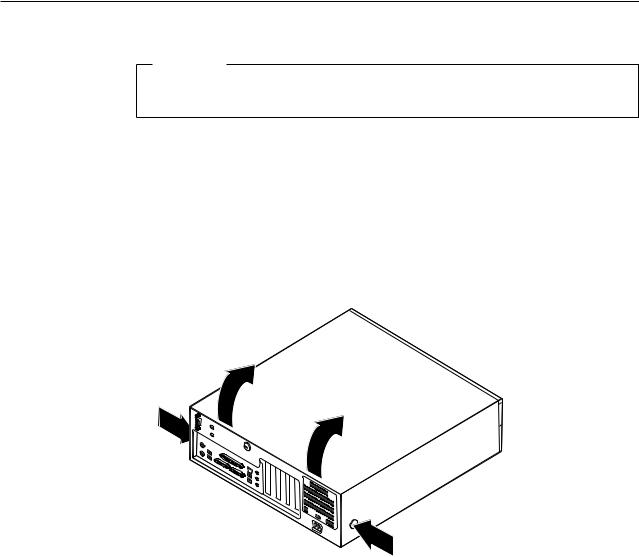
Removing the cover
Important
Read “Safety Information” on page v and “Handling static-sensitive devices” on page 5 before removing the cover.
To remove the cover:
1.Shut down your operating system, remove any media (diskettes, CDs, or tapes) from the drives, and turn off all attached devices and the computer.
2.Unplug all power cords from electrical outlets.
3.Disconnect all cables attached to the computer. This includes power cords, input/output (I/O) cables, and any other cables that are connected to the computer.
4.Press the buttons on the sides of the computer and pivot the rear end of the cover up toward the front of the computer.
Chapter 1. Type 8316 9
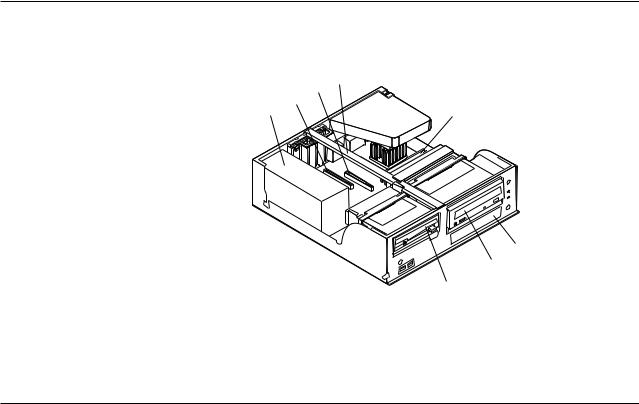
Locating components
The following illustration will help you locate the various components in your computer.
|
|
|
|
|
|
|
|
|
|
|
|
|
|
|
|
|
|
|
|
|
|
|
|
|
|
|
|
|
|
|
|
|
|
|
|
|
|
|
|
|
|
|
|
|
|
|
|
|
|
|
|
|
|
|
|
|
|
|
|
|
|
|
|
|
|
|
|
|
|
|
|
|
|
|
|
|
|
|
|
|
|
|
|
|
|
|
|
|
|
|
|
|
|
|
|
|
|
|
|
|
|
|
|
|
|
|
|
|
|
|
|
|
|
|
|
|
|
|
|
|
|
|
|
|
|
|
|
|
|
|
|
|
|
|
|
|
|
|
|
|
|
|
|
|
|
|
|
|
|
|
|
|
|
|
|
|
|
|
|
|
|
|
|
|
|
|
|
|
|
|
|
|
|
|
|
|
|
|
|
|
|
|
|
|
|
|
1Power supply |
|
|
|
|
|
5DIMM |
||||||||||
2PCI slot |
|
|
|
|
|
6Hard disk drive |
||||||||||
3AGP slot |
|
|
|
|
|
7CD-ROM drive or DVD-ROM drive |
||||||||||
4Support bar |
|
|
|
|
|
8Diskette drive |
||||||||||
Identifying parts on the system board
The system board (sometimes called the planar or motherboard) is the main circuit board in your computer. It provides basic computer functions and supports a variety of devices that are IBM-installed or that you can install later.
10 User Guide
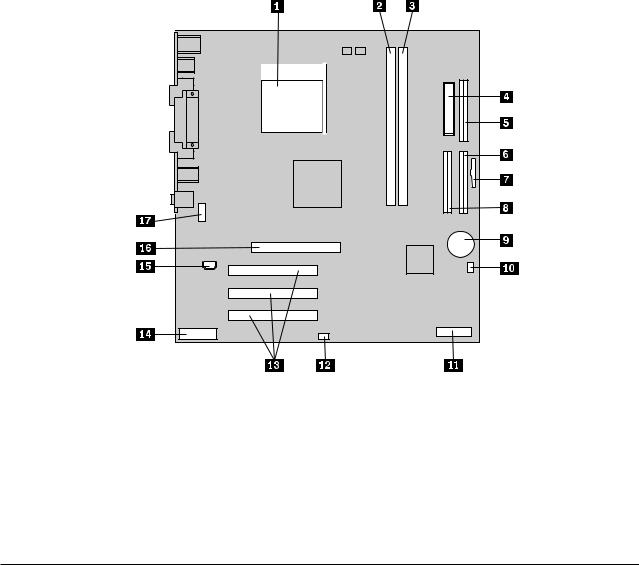
The following illustration shows the locations of parts on the system board.
1 Microprocessor 2 DIMM connector 1 3 DIMM connector 2 4 Power connector
5 Diskette drive connector 6 Primary IDE connector 7 Front panel connector 8 Secondary IDE connector 9 Battery
10Clear CMOS/Recovery jumper 11POV card (some models) 12SCSI LED connector
13PCI slots
14Front panel audio connector 15CD-ROM audio connector 16AGP slot (some models) 17Serial connector
Installing memory
Your computer has two connectors for installing dual inline memory modules (DIMMs) that provide up to a maximum of 2.0 GB of system memory.
When installing DIMMs, the following rules apply:
vFill each system memory connector sequentially, starting at DIMM connector 1.
vUse 2.5 V, 184-pin, 266 MHz double data rate synchronous dynamic random access memory (DDR SDRAM).
vUse 128 MB, 256 MB, 512 MB or 1.0 GB (when available) DIMMs in any combination.
vDIMMs are 38.1 mm (1.5 inches) in height.
Note: Only DDR SDRAM DIMMs can be used.
To install a DIMM:
1. Remove the cover. See “Removing the cover” on page 9.
Chapter 1. Type 8316 11
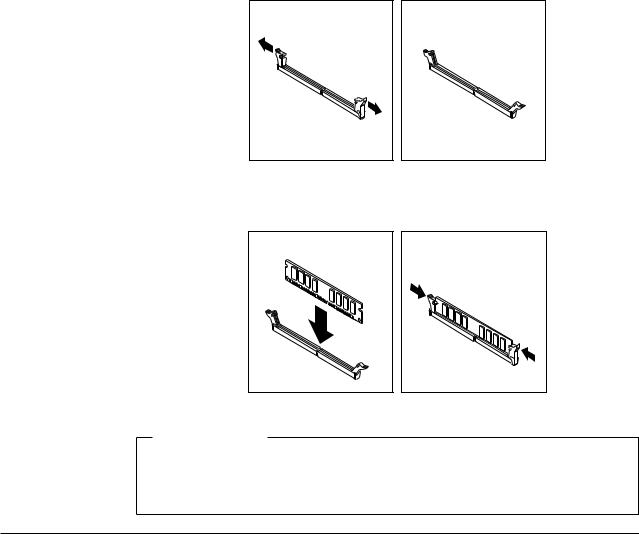
2.To locate the DIMM connectors. See “Identifying parts on the system board” on page 10.
3.Open the retaining clips.
4.Make sure the notches in the DIMM align with the tabs on the connector. Push or insert the DIMM straight down into the connector until the retaining clips close.
What to do next:
vTo work with another option, go to the appropriate section.
vTo complete the installation, go to “Replacing the cover and connecting the cables” on page 21.
Installing adapters
This section provides information and instructions for installing and removing adapters. Your computer has three expansion slots for PCI adapters. One slot, used for an AGP adapter, is available on some models. Adapters must be low profile. Your computer supports adapters up to 168 mm (6.6 inches) long.
To install an adapter:
1. Remove the cover. See “Removing the cover” on page 9.
12 User Guide
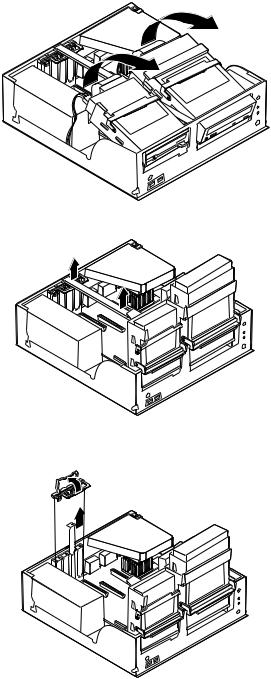
2.Pivot one of the drive bay latch handles toward the front of the computer and then pivot the drive bay cage upward, as shown, until it is latched in the up position. Repeat this procedure for the remaining drive bay.
3. Remove the support bar by pulling it outward from the computer.
4.Remove the adapter-slot-cover latch and the slot cover for the appropriate expansion slot.
5.Remove the adapter from its static-protective package.
6.Install the adapter into the appropriate slot on the system board.
Chapter 1. Type 8316 13
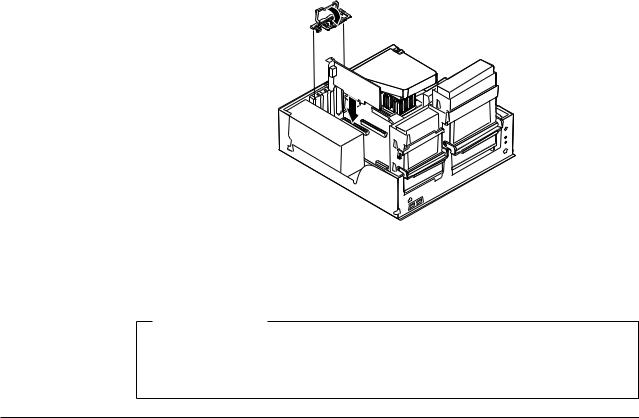
7. Install the adapter-slot-cover latch.
8.Clear any cables that might impede the replacement of the drive bays.
9.Replace the support bar and pivot the two drive bays back to their original positions.
What to do next:
vTo work with another option, go to the appropriate section.
vTo complete the installation, go to “Replacing the cover and connecting the cables” on page 21.
Installing internal drives
This section provides information and instructions for installing and removing internal drives.
Internal drives are devices that your computer uses to read and store data. You can add or replace drives to your computer to increase storage capacity and to enable your computer to read other types of media such as CD-ROM.
Internal drives are installed in bays. In this book, the bays are referred to as bay 1, bay 2, and so on.
When you install an internal drive, it is important to note what type and size of drive that you can install in each bay. Also, it is important to correctly connect the internal drive cables to the installed drive.
Drive specifications
Your computer might come with the following IBM-installed drives:
vA 3.5-inch diskette drive in bay 1
vA CD-ROM drive or DVD-ROM drive in bay 2 (some models)
vA 3.5-inch hard disk drive in bay 3
Any bay that does not have a drive installed has a static shield and bay panel installed.
14 User Guide

The following illustration shows the locations of the drive bays.
The following list describes some of the drives that you can install in each bay and their height requirements:
1Bay 1 - Maximum height: 25.8 mm (1.0 in.) 3.5-inch diskette drive (preinstalled) 2Bay 2 - Maximum height: 43.0 mm (1.7 in.) CD-ROM drive or DVD-ROM drive
(preinstalled in some models) 3Bay 3 - Maximum height: 25.8 mm (1.0 in.) 3.5-inch hard disk drive (preinstalled)
Notes:
1.Drives that are greater than 43.0 mm (1.7 in.) high cannot be installed.
2.Install removable media (tape or CD) drives in the accessible bay (bay 2).
Installing a CD-ROM or DVD-ROM drive
To install a CD-ROM drive or DVD-ROM drive in bay 2, follow these steps:
1.Remove the cover (see “Removing the cover” on page 9).
2.Remove the bay panel from the front bezel.
3.Remove the metal shield from the drive bay by inserting a flat-blade screwdriver into one of the slots and gently prying it loose.
4.Make sure the drive is set correctly as the master device. Refer to the documentation that comes with your CD-ROM drive or DVD-ROM drive for master/slave jumper information.
5.Pivot the drive bay latch handle toward the front of the computer and then pivot the drive bay cage upward, as shown, until it is latched in the up position.
Chapter 1. Type 8316 15
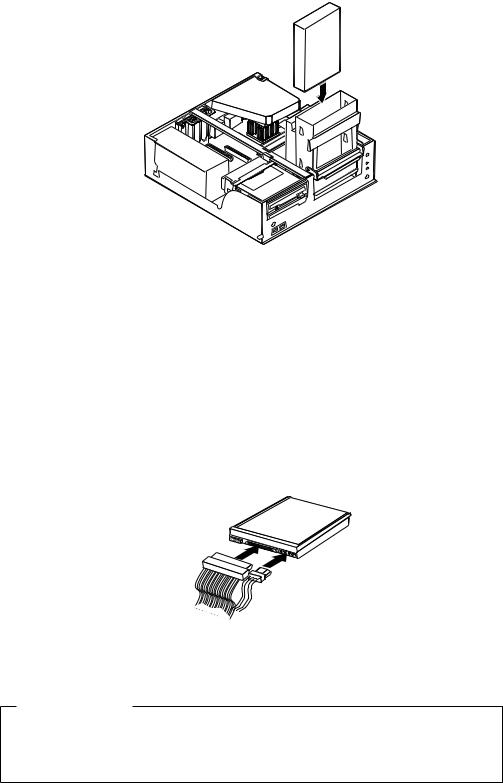
6. Install the drive into the bay. Align the screw holes and insert the two screws.
7.Each integrated drive electronics (IDE) drive requires two cables; a four-wire power cable that connects to the power supply, and a signal cable that connects to the system board. For a CD-ROM drive, you might also have an audio cable.
To connect a CD-ROM drive or DVD-ROM drive to your computer, follow these steps:
a.Locate the signal cable that comes with your computer or with the new drive.
b.Locate the secondary IDE connector on the system board. See “Identifying parts on the system board” on page 10.
c.Connect one end of the signal cable to the secondary IDE connector on the system board and the other to the CD-ROM drive or DVD-ROM drive.
d.Your computer has extra power connectors for connecting additional drives. Connect the power cable to the drive.
8.Clear any cables that might impede replacement of the drive cage.
9.Pivot the drive cage back into place.
What to do next:
vTo work with another option, go to the appropriate section.
vTo complete the installation, go to “Replacing the cover and connecting the cables” on page 21.
16 User Guide

Installing security features
To help prevent hardware theft and unauthorized access to your computer, several security lock options are available. The following sections will help you identify and install the various types of locks that might be available for your computer. In addition to physical locks, unauthorized use of your computer can be prevented by a software lock that locks the keyboard until a correct password is typed in.
Make sure that any security cables you install do not interfere with other computer cables.
Identifying security locks
The following illustration shows the locations of the security features on the rear of the computer.
1Rope clip 2Integrated cable lock
Rope clip
Using a 3/16-inch or 5-mm rope clip (sometimes referred to as a U-bolt), a steel security cable, and a padlock can secure your computer to a desk, table, or other non-permanent fixture. For computers designed to accommodate the rope clip, knockouts at the rear of the chassis are provided.
To install a rope clip:
1.Remove the cover (see “Removing the cover” on page 9).
2.Use a tool, such as a screwdriver, to remove the two metal knockouts.
3.Press both sides of the air baffle and lift it outward from the computer to remove.
4.Insert the rope clip through the rear panel; then attach and tighten the nuts with an appropriately sized or adjustable wrench.
Chapter 1. Type 8316 17
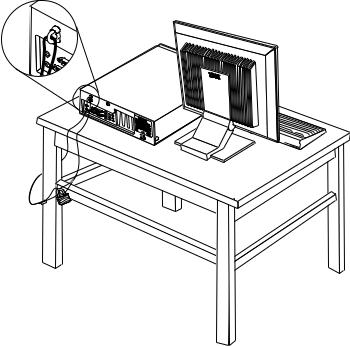
5.Replace the computer cover. For more information, see “Replacing the cover and connecting the cables” on page 21.
6.Thread the cable through the rope clip and around an object that is not a part of or permanently secured to the building structure or foundation, and from which it cannot be removed; then fasten the cable ends together with a lock.
18 User Guide
